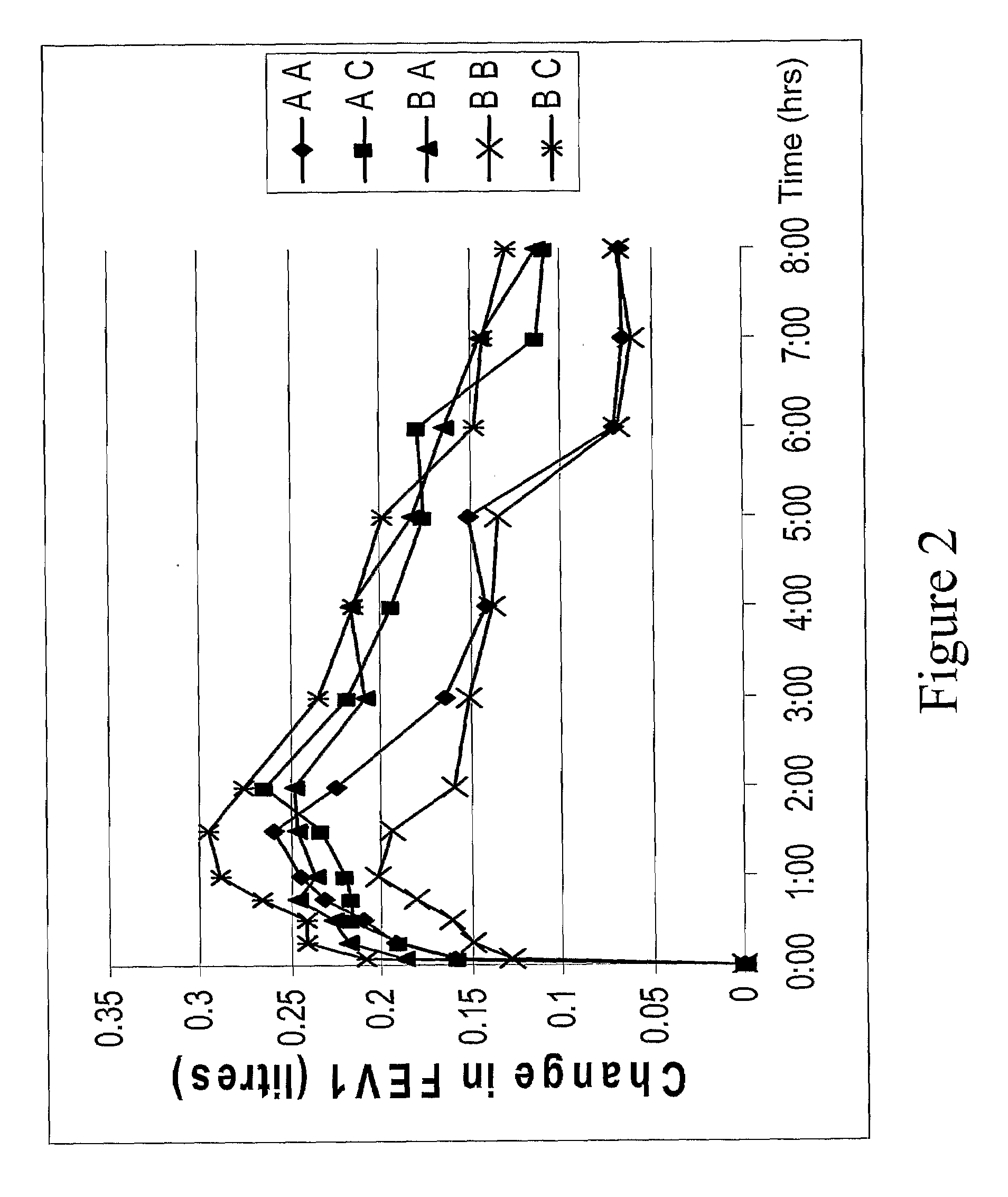Methods for Identifying a Patient as a Candidate for Treatment with a Long Acting Beta Agonist and for Predicting a Patient's Response to Long Acting Beta2 Agonist Therapy by Analysing Polymorphisms in the Beta2-Adrenergic Receptor Gene
a technology of beta2-adrenergic receptor and polymorphisms, which is applied in the field of identifying a patient as a candidate for treatment with a long-acting beta agonist and predicting a patient's response to long-acting beta2-agonist therapy by analysing polymorphisms in the beta2-adrenergic receptor gene, can solve the problems of long-term use of any drug that may have different effects on different individuals, and achieves limited revers
- Summary
- Abstract
- Description
- Claims
- Application Information
AI Technical Summary
Benefits of technology
Problems solved by technology
Method used
Image
Examples
example 1
[0152]Samples for genotyping were taken from 2450 patients recruited in four Viozan™ phase III clinical trials, namely SC-397-5097, SC-397-5098, SC-397-5099 and SC-397-5163. The patient population included male and female patients, aged 40 to 80 years, with stable COPD, symptoms for ≧2 years, and a smoking history of at least 15 pack years. Patients demonstrating pre- and post-bronchodilator FEV1 / FVC (forced vital capacity)<65% and pre- and post-bronchodilator FEV1 20-70% of the predicted normal, were included in the study. Further details about the patient population, and the study designs, are described in Laursen et al. Respiratory Medicine (2003), Vol 97, Suppl A, S23-S33. Participation in the genetics sub-study was voluntary. Patients gave separate written informed consent for the genetic analysis. Patients all consented to provide DNA for use in studying the response to Viozan™. Viozan™ is a dual agonist, targeting the β2-adrenergic receptor and the dopamine β2 receptor genes,...
example 2
Haplotype-Lung Function Analysis
[0161]Pre- and post-dose FEV1 (forced expiratory volume in 1 second), the volume of air exhaled in the first second of the FVC manoeuvre (expressed in litres), measurements were taken at each study visit for all patients, as described in the clinical study protocols. Spirometry measurements were performed using a standard technique at each centre. Details about the spirometer used and the calibration records were provided by each centre. After resting for 15 minutes, slow vital capacity (SVC), forced vital capacity (FVC) and FEV1 were measured for at least three separate manoeuvres. The greatest values for each parameter were recorded.
[0162]In a subset of patients (all of whom exhibited ≧5% reversibility of FEV1 in response to inhaled SABA salbutamol 400 μg), serial FEV1 measurements were taken over an 8 hr period (at 5, 15, 30, 45, 60, 90, and 120 minutes and hourly thereafter until 8 hrs post-dosing). Serial measurements were taken on day 1 (studies...
example 3
Haplotype-Symptom Score Correlations
[0168]Changes in COPD symptoms were assessed using the BCSS (breathlessness, cough and sputum score), also referred to as the TSS (total symptom score). Each symptom, that is breathlessness, cough and sputum, was evaluated daily by the patient and recorded in a diary using a 5-point Likert scale (ranging from 0 to 4, with the higher values indicating more sever symptoms). The three item scores were summed to calculate the BCSS total score, resulting in a value between 0 and 12. The reliability and validity of the BCSS for evaluating symptoms in COPD is discussed in Leidy et al, 2003, Respiratory Medicine, Vol 97, SupplA, S59-S70. A mean change of ±1 point on the BCSS total score represents a substantial improvement in symptom severity for patients with moderate to severe COPD (Celli et al. Respiratory Medicine, (2003) Vol 97, SupplA, S35-43).
[0169]FIG. 5 shows the change from baseline BCSS for subgroups of patients stratified by the ADRB2 haplotyp...
PUM
| Property | Measurement | Unit |
|---|---|---|
| pH | aaaaa | aaaaa |
| frequency | aaaaa | aaaaa |
| time | aaaaa | aaaaa |
Abstract
Description
Claims
Application Information
 Login to View More
Login to View More - R&D
- Intellectual Property
- Life Sciences
- Materials
- Tech Scout
- Unparalleled Data Quality
- Higher Quality Content
- 60% Fewer Hallucinations
Browse by: Latest US Patents, China's latest patents, Technical Efficacy Thesaurus, Application Domain, Technology Topic, Popular Technical Reports.
© 2025 PatSnap. All rights reserved.Legal|Privacy policy|Modern Slavery Act Transparency Statement|Sitemap|About US| Contact US: help@patsnap.com



